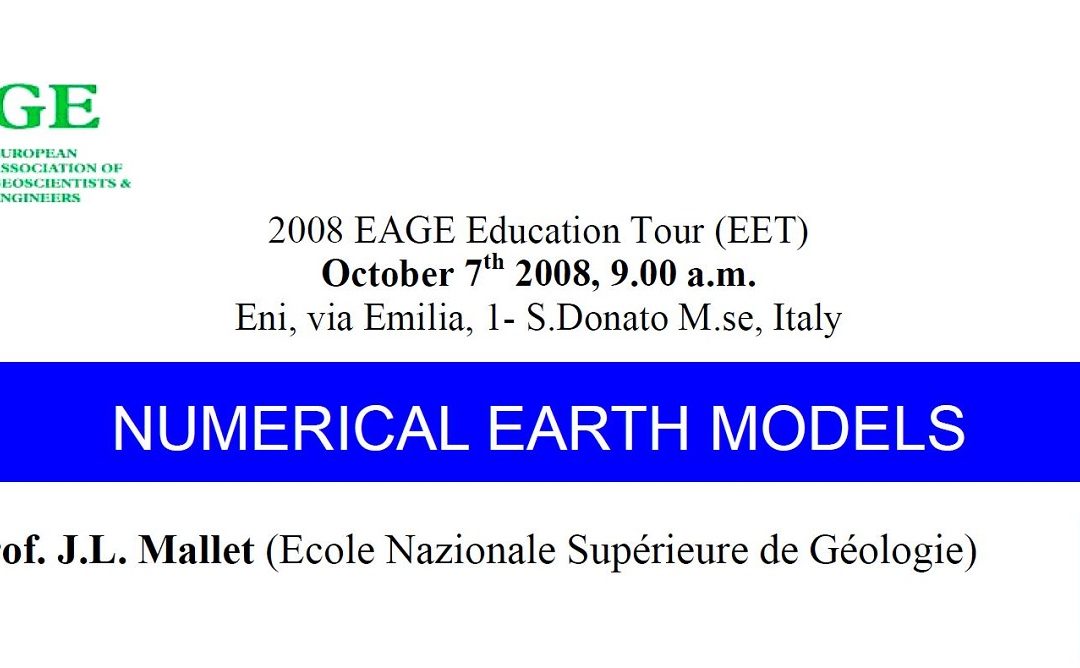prof. J.L. Mallet (Ecole Nazionale Supérieure de Géologie)
NUMERICAL EARTH MODELS
2008 EAGE Education Tour (EET)
October 7th 2008, 9.00 a.m.
Eni, via Emilia, 1- S.Donato M.se, Italy
ABSTRACT
Three-dimensional numerical earth models play an increasingly important role in the E&P industry to improve reservoir management and optimise hydrocarbon recovery. Regarding an oil-&-gas reservoir, there are only two fundamental questions that constitute the basis of exploration and production of hydrocarbons: 1) How much can we expect to earn and 2) How much could we lose?
Answering these two questions correctly is crucial to making the right decision, which arises immediately after having spent tens of millions of dollars to acquire data on a lease and rights before again spending hundreds of millions of dollars to develop the oil field. Such a decision has to be taken on the basis of a numerical model of the subsurface, integrating all the data and knowledge that have been collected and interpreted by a series of geoscientists, from the geophysical interpretation to the flow simulator. This course presents several types of approaches that can be used to build such models, while pointing out their pros and cons. The course addresses the following questions:
- What methods are used in classical Computer Aided Design (CAD) and why are they not used to model the subsurface?
- What discrete modelling methods are used in geology to model the geometry, topology and physical properties of the subsurface?
- How does one extract information regarding the geometry and properties of the subsurface from a seismic cube?
- What is a Shared Earth Model (SEM) and what are its intrinsic limitations?
- How does the concept of «Unified Earth Model» (UEM) allow the limitations of SEMs to be removed?
- Why must flow simulation grids, called FlowGrids, used by flow simulators be built independently of the property model?
- How can FlowGrids be designed optimally to ensure the stability of the numerical algorithms used by flow simulators?
- Why must FlowGrids not be considered as “Earth Models”?
WHO SHOULD ATTEND
The course is aimed at geophysicists, structural geologists, geostatisticians and reservoir engineers who are involved in the construction of Earth models and wish to:
- learn about how geomodelling software works
- understand the limitations of the current software
- understand how information is extracted from seismic cubes
- see how to eliminate limitations induced by complex fault networks
- feed flow simulators with optimal models
The course can be understood by geoscientists with a moderate mathematical background. The only prerequisites are second-degree equations, trigonometric functions and matrix products.
BIOGRAPHY
Professor Jean-Laurent Mallet graduated from the Ecole-Nationale-Supérieure-de-Géologie (Nancy/France) in 1968. He next diversified his interests into applied mathematics, finishing his research education with a PhD in applied mathematics and computer sciences at the Institut-National-Polytechnique-de-Lorraine (INPL). In his early years, he worked with the CNRS in the field of numerical data analysis and automated mapping. In 1981, he was nominated Professor at the Ecole-Nationale-Supérieure-de-Géologie (ENSG), from which he directed teaching of and research into applications of computer sciences related to geology.
Professor Mallet’s research is at the frontier of mathematics, geosciences and the computer sciences. He has contributed in many ways to the progress of sciences and technology in the field of Oil and Gas. He headed the Gocad Research Consortium from 1989 to 2006. He was awarded several international prizes, such as the «Italgaz Prize» (1997–Italy), the “Antony-Lucas Gold Medal” (2000–SPE), the “Grand Prix Dolomieu” (2003–French Academy of Sciences) and the “Prix Roubault” (2005–Union of French Geologists). Professor Mallet retired from the university in 2006 and he is now “Emeritus Professor” at the Ecole-Nationale-Supérieure-de-Géologie and “Research Fellow” at Paradigm-Geophysical.


Recent Comments